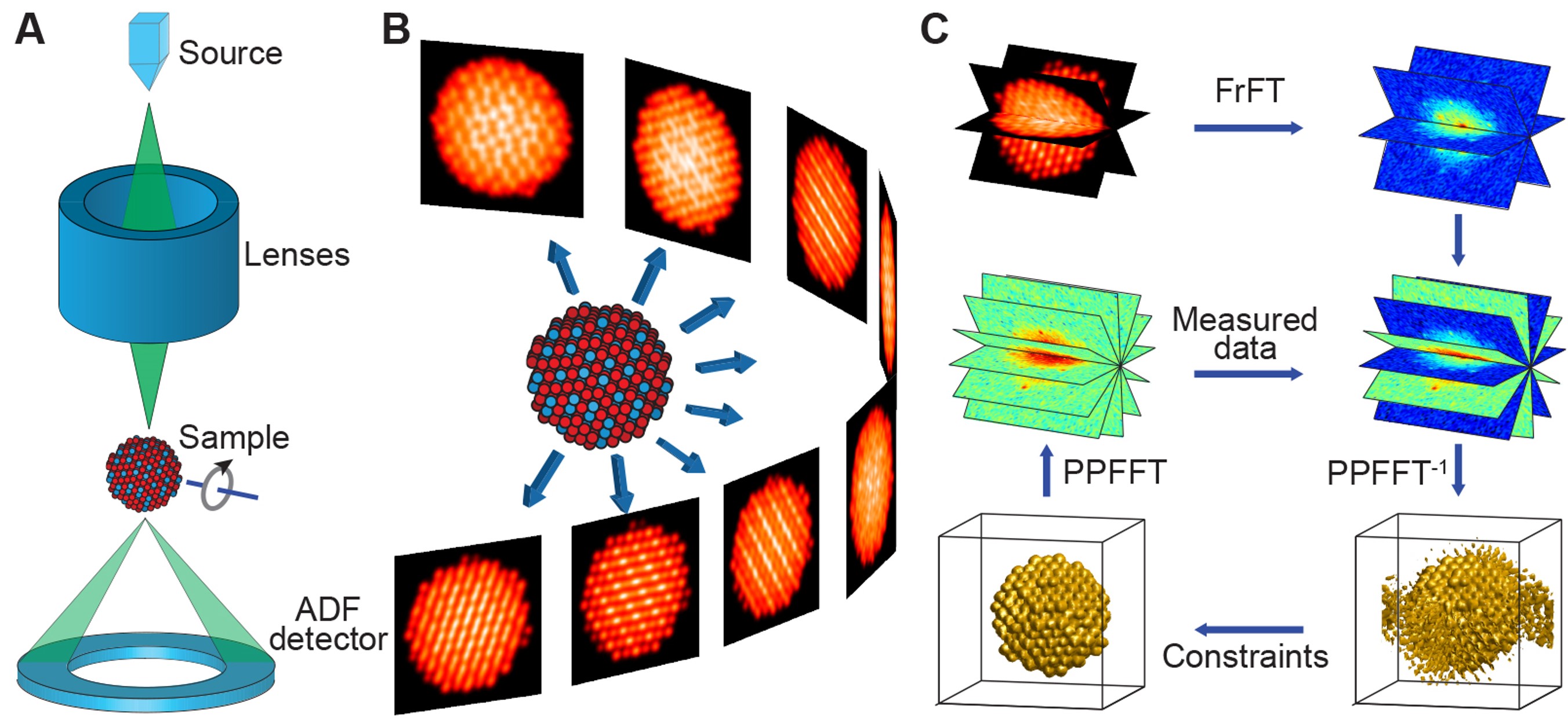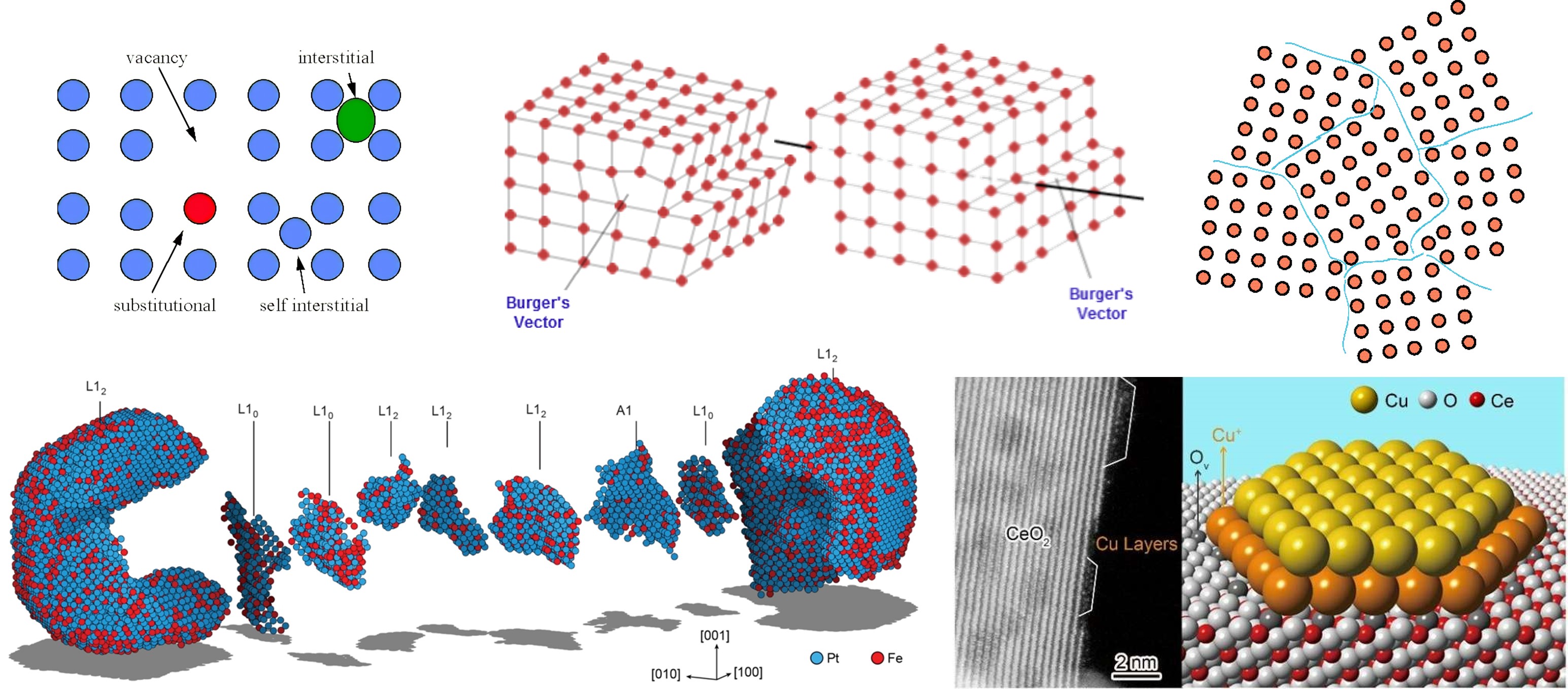Atomic electron tomography (AET) combinesthe advance transmission electron microscope with the state-of-art 3D reconstruction algorithm to get the atomic information in 3D.

Schematic diagram of AET
In AET, a series of 2D images are measured with advanced electron microscopy by tilting a sample to many different orientations. The 3D structure of the sample is iteratively reconstructed from the images and the coordinates of individual atoms are localized.

Different defects in materials
AET enables 3D imaging of crystal defects such as grain boundaries, stacking faults, dislocations and point defects at atomic resolution. The ability to precisely determine the coordinates of individual atoms allows direct measurements of atomic displacements and the full strain tensor in materials.
More recently, we reported, for the first time, the determination of the 3D coordinates of around 18000 atoms in a multi-component metallic glass with a precision of ~21 picometer. The positions of all the atoms in a sample of a metallic glass have been measured experimentally — fulfilling a decades-old dream for glass scientists, and raising the prospect of fresh insight into the structures of disordered solids.
Atomic model of metallic glass nanoparticle
From the coordinates of these individual atoms, we measured the short-range order and medium-range order in the sample. And we found that although the atoms alignments are disordered in short-range, in medium range, the solute atoms will form crystal like MRO structure with translational order but no orientational order.
References:
1. J. Miao, P. Ercius and S. J. L. Billinge, "Atomic electron tomography: 3D structures without crystals", Science, 353, aaf2157 (2016).
2. Y. Yang*, J. Zhou*, F. Zhu*, Y. Yuan*, D. Chang, D. S. Kim, M. Pham, A. Rana, X. Tian, Y. Yao, S. J. Osher, L. Hu, P. Ercius, J. Miao. Determining the three-dimensional atomic structure of an amorphous solid. Nature, 592, 60–64 (2021).
3. J. Zhou*, Y. Yang*, Y. Yang, D. S Kim, A. Yuan, X. Tian, C. Ophus, F. Sun, A. K. Schmid, M. Nathanson, H. Heinz, Q. An, H. Zeng, P. Ercius, J. Miao. Observing crystal nucleation in four dimensions using atomic electron tomography. Nature, 570, 500–503 (2019)
4. Y. Yang*, C.-C. Chen*, M. C. Scott*, C. Ophus*, R. Xu, A. Pryor Jr., L. Wu, F. Sun, W. Theis, J. Zhou, M. Eisenbach, P. R. C. Kent, R. F. Sabirianov, H. Zeng, P. Ercius, and J. Miao, "Deciphering chemical order/disorder and material properties at the single-atom level", Nature, 542, 75-79 (2017).
5. Y. Yuan*, D. S. Kim*, J. Zhou*, D. J. Chang, F. Zhu, Y. Nagaoka, Y. Yang, M. Pham, S. J. Osher, O. Chen, P. Ercius, A. K. Schmid, J. Miao. Direct observation of 3D atomic packing in monatomic amorphous materials. Nature Materials, 21, 95–102 (2022).
6. X. Tian*, D. S. Kim*, S. Yang*, C. J. Ciccarino, Y. Gong, Y. Yang,Y. Yang, B. Duschatko, Y. Yuan, P. M. Ajayan, J. C. Idrobo, P. Narang, J. Miao. Correlating the three-dimensional atomic defects and electronic properties of two-dimensional transition metal dichalcogenides. Nature Materials, 19, 867–873 (2020).